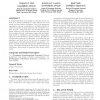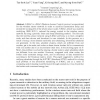647 search results - page 75 / 130 » Extending middleware frameworks for Wireless Sensor Networks |
EWSN
2006
Springer
14 years 8 months ago
2006
Springer
Time synchronization is a crucial component of a large class of sensor network applications, traditionally implemented as a standalone middleware service that provides a virtual gl...
MSWIM
2004
ACM
14 years 2 months ago
2004
ACM
A fundamental issue in the design of a wireless sensor network is to devise mechanisms to make efficient use of its energy, and thus, extend its lifetime. Due to the paramount imp...
GLOBECOM
2008
IEEE
13 years 10 months ago
2008
IEEE
—The proliferation of wireless systems requires that the coexistence between heterogeneous technologies be addressed. This paper presents a cognitive framework in which sensingba...
EUROGP
2005
Springer
14 years 2 months ago
2005
Springer
Abstract. Wireless sensor networks (WSNs) are medium scale manifestations of a paintable or amorphous computing paradigm. WSNs are becoming increasingly important as they attain gr...
HPCC
2005
Springer
14 years 2 months ago
2005
Springer
S-MAC is a MAC (Medium Access Control) protocol as specialized for the wireless sensor network in order to sacrifice transmission delay and extend the working life of the whole sen...


